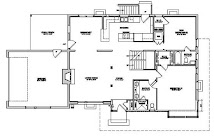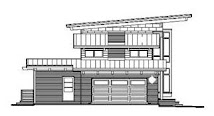

5506 Riverside Drive Richmond, VA


 It's the Saturday after Christmas and the 50+ degree rain last night melted most of the snow. The only snow that remains are small piles where the roads were scraped.
It's the Saturday after Christmas and the 50+ degree rain last night melted most of the snow. The only snow that remains are small piles where the roads were scraped.





 From the time this image was taken till the end of the day, the framers finished the roof. This includes near-flat roof at the back and the section over the porch. This porch used to be our sunroom and may one day be that again. For now it will stay a covered porch.
From the time this image was taken till the end of the day, the framers finished the roof. This includes near-flat roof at the back and the section over the porch. This porch used to be our sunroom and may one day be that again. For now it will stay a covered porch.That detail now creates a decision for me. Do we replace the block with brick which will then be painted with the rest of the wall, or do we put a trim board over it. The latter is cheaper and might look just fine.
It is getting much easier to understand the volume which will be the living room. The front (tall) window is now framed in. To me, this is the most important, but undesigned room in the house. This room is most important because this is where all the special details and materials are seen - wood beams, unique windows, fireplace, balcony railings, and kitchen.
The more I see this room, the more important that the fireplace wall becomes. My original and current thought is to put a grid of bookshelves on either side of the fireplace - up to a 9' or 10' height. With the height of that wall, it will be important to use these as a design feature to humanize the 14' height. They should match either the height of the adjacent window or the ceiling line under the balcony. Pulling from one of these lines will help unify the space. The budget may delay this for the time-being.
It would be very dramatic to put the chimney stone on the inside face of the fireplace wall - all the way up to the ceiling. The wood ceiling beams will then frame either side.
I'm starting to realize just how many decisions are still to be made - and some design tweaks that I'm finding now that I see the space. Architects have an enhanced ability to understand theoretical space, but there's nothing quite like being in the actual built space to really see how space is connected and how the details intersect.


 It's a rainy Saturday and I've included a few new images of the house. The outside is starting to show its overall form though it's hard to tell with all the tarps that cover everything. The contractor has done a nice job of keeping everything dry during all the rainstorms. They button everything up at the end of each day.
It's a rainy Saturday and I've included a few new images of the house. The outside is starting to show its overall form though it's hard to tell with all the tarps that cover everything. The contractor has done a nice job of keeping everything dry during all the rainstorms. They button everything up at the end of each day. 



 We're in Virginia Beach for Thanksgiving weekend and not able to see the progress until Sunday night. It's been another rainy week but that didn't stop the "progress" of demolition. With the official rainfall at more than 8" for November (a record total), it is a wonder that the contractors got as much done as they did. The front yard is now a big mudpuddle from the vehicle traffic that goes back and forth
We're in Virginia Beach for Thanksgiving weekend and not able to see the progress until Sunday night. It's been another rainy week but that didn't stop the "progress" of demolition. With the official rainfall at more than 8" for November (a record total), it is a wonder that the contractors got as much done as they did. The front yard is now a big mudpuddle from the vehicle traffic that goes back and forth
 Today, I had a hike for the Tiger den at Maymont. As we walked around the Dooley mansion, I realized I might see our house from the lawn overlooking the river. From there, it was quite easy to pick out the blue tarp that now covers our roof. After the walk, I went to the house and sure enough from our front yard (with the leaves almost gone), you can now see the green copper roof of the mansion down-river.
Today, I had a hike for the Tiger den at Maymont. As we walked around the Dooley mansion, I realized I might see our house from the lawn overlooking the river. From there, it was quite easy to pick out the blue tarp that now covers our roof. After the walk, I went to the house and sure enough from our front yard (with the leaves almost gone), you can now see the green copper roof of the mansion down-river.
 After 10 inches of rain and crazy wind over a 5 day period, they finally got started on the real demolition work.
After 10 inches of rain and crazy wind over a 5 day period, they finally got started on the real demolition work.
 The only new foundation required on the outside is at the entry corner. The rest of the new construction will occur on and within the existing walls. This new corner will align with the existing structural line, simplifying the geometry and appearance of the main addition.
The only new foundation required on the outside is at the entry corner. The rest of the new construction will occur on and within the existing walls. This new corner will align with the existing structural line, simplifying the geometry and appearance of the main addition.
It will be a bit shocking to see the house as a shell, but it won't stay that way long. If the weather is normal for this time of year, we should be under roof by December 1.
 We finish the move on Wednesday and construction begins on Monday November 2. I will be using this site to illustrate and explain the construction as it goes up. If all goes as planned, we'll be under roof by December 1 and complete by May 1, 2010.
We finish the move on Wednesday and construction begins on Monday November 2. I will be using this site to illustrate and explain the construction as it goes up. If all goes as planned, we'll be under roof by December 1 and complete by May 1, 2010. 






